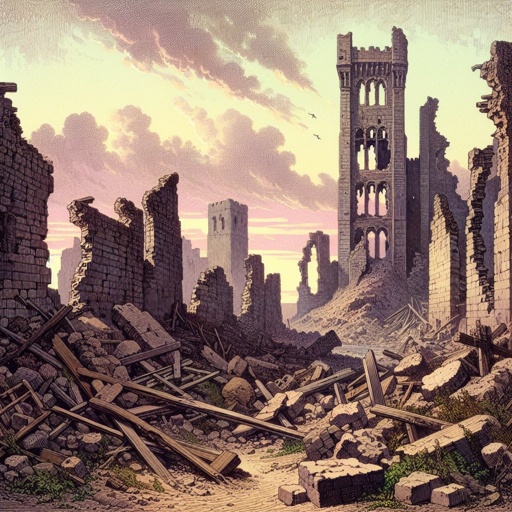What does Psalms 40:1 mean?
"I waited patiently for the LORD; and he inclined unto me, and heard my cry." - Psalms 40:1

Psalms 40:1 - "I waited patiently for the LORD; and he inclined unto me, and heard my cry."
Please generate an image depicting the verse, Psalms 40:1 - 'I waited patiently for the LORD; and he inclined unto me, and heard my cry.' The style should be modern and vibrant to resemble digital art. The scenery might feature a solitary figure under the expansive sky, appealing for solace, while a divine entity bows down from the heavens, suggesting that the prayers are being heeded.
Psalms 40:1 in the King James Version of the Bible reads: "I waited patiently for the Lord; and he inclined unto me, and heard my cry." This verse is a powerful testament to the faith and trust that the psalmist has in God, and it reflects the themes of patience, perseverance, and the faithfulness of God.
The book of Psalms is a collection of prayers, poems, and songs that were used in worship in ancient Israel. These writings are deeply personal and emotional, often expressing the highs and lows of the human experience and the relationship between God and his people. In Psalm 40, the psalmist begins by praising God for delivering him from a place of distress and despair. The psalmist testifies to the steadfast love and faithfulness of God and expresses his gratitude for being lifted out of the slimy pit and set upon a rock (v. 2).
In verse 1, the psalmist declares that he waited patiently for the Lord and that God inclined to him and heard his cry. This statement reflects the psalmist's trust and confidence in God's ability to respond to his prayers and deliver him from his troubles. It conveys the idea that waiting on the Lord is an active and intentional practice, and it requires both patience and a deep-seated faith in God's goodness and faithfulness.
The concept of waiting on the Lord is a recurring theme in the Bible, and it often implies a period of uncertainty, hardship, or trial. This waiting can be difficult and challenging, but it is also an opportunity for growth, renewal, and spiritual transformation. The psalmist's declaration of patiently waiting for the Lord encourages believers to trust in God's timing and to hold onto hope even in the midst of adversity.
The image of God inclining to the psalmist and hearing his cry conveys the intimacy and compassion of God. It depicts God as attentive and responsive to the prayers of his people, always ready to come to their aid and provide comfort and support. This image of God inclining towards the psalmist also implies a posture of closeness and attentiveness, emphasizing the personal nature of the relationship between God and his people.
The themes of waiting, patience, and the faithfulness of God in Psalm 40:1 are relevant and meaningful in the context of various life situations. Whether facing personal struggles, waiting for answers to prayer, or enduring periods of uncertainty and hardship, this verse offers comfort and encouragement. It reminds believers that God is present in their waiting, that he hears their cries, and that he is faithful to respond in his own perfect timing.
In addition to its themes, Psalm 40:1 also carries important symbolic and metaphorical meanings. The image of being lifted out of the slimy pit and set upon a rock (v. 2) can be understood as a metaphor for being rescued from the depths of despair and established on a firm foundation. This imagery conveys the idea of deliverance and restoration, illustrating God's ability to bring hope and renewal in the midst of darkness and adversity.
Overall, Psalm 40:1 in the King James Version of the Bible offers a profound reflection on the themes of waiting, patience, and the faithfulness of God. It serves as a source of hope and encouragement for believers, reminding them of the intimate and compassionate nature of God and his unwavering commitment to those who put their trust in him.
Psalms 40:1 Artwork

Psalms 40:1 - "I waited patiently for the LORD; and he inclined unto me, and heard my cry."

Psalms 78:40 - "How oft did they provoke him in the wilderness, and grieve him in the desert!"

Psalms 105:40 - "The people asked, and he brought quails, and satisfied them with the bread of heaven."

Psalms 40:7 - "Then said I, Lo, I come: in the volume of the book it is written of me,"

Psalms 40:15 - "Let them be desolate for a reward of their shame that say unto me, Aha, aha."

Psalms 128:1 - "Blessed is every one that feareth the LORD; that walketh in his ways."

Psalms 107:40 - "He poureth contempt upon princes, and causeth them to wander in the wilderness, where there is no way."

Psalms 119:40 - "Behold, I have longed after thy precepts: quicken me in thy righteousness."

Psalms 40:13 - "Be pleased, O LORD, to deliver me: O LORD, make haste to help me."

Psalms 122:1 - "I was glad when they said unto me, Let us go into the house of the LORD."

Psalms 40:4 - "Blessed is that man that maketh the LORD his trust, and respecteth not the proud, nor such as turn aside to lies."

Psalms 106:40 - "Therefore was the wrath of the LORD kindled against his people, insomuch that he abhorred his own inheritance."

Psalms 40:8 - "I delight to do thy will, O my God: yea, thy law is within my heart."

Psalms 64:1 - "Hear my voice, O God, in my prayer: preserve my life from fear of the enemy."

Psalms 18:40 - "Thou hast also given me the necks of mine enemies; that I might destroy them that hate me."

Psalms 89:40 - "Thou hast broken down all his hedges; thou hast brought his strong holds to ruin."

Psalms 55:1 - "Give ear to my prayer, O God; and hide not thyself from my supplication."

Psalms 40:16 - "Let all those that seek thee rejoice and be glad in thee: let such as love thy salvation say continually, The LORD be magnified."

Psalms 40:9 - "I have preached righteousness in the great congregation: lo, I have not refrained my lips, O LORD, thou knowest."

Psalms 9:1-2

Psalms 92:1 - "It is a good thing to give thanks unto the LORD, and to sing praises unto thy name, O most High:"

Psalms 40:11 - "Withhold not thou thy tender mercies from me, O LORD: let thy lovingkindness and thy truth continually preserve me."

Psalms 108:1 - "O God, my heart is fixed; I will sing and give praise, even with my glory."

Psalms 40:6 - "Sacrifice and offering thou didst not desire; mine ears hast thou opened: burnt offering and sin offering hast thou not required."

Psalms 37:40 - "And the LORD shall help them, and deliver them: he shall deliver them from the wicked, and save them, because they trust in him."

Psalms 40:14 - "Let them be ashamed and confounded together that seek after my soul to destroy it; let them be driven backward and put to shame that wish me evil."

Psalms 95:10 - "Forty years long was I grieved with this generation, and said, It is a people that do err in their heart, and they have not known my ways:"

Psalms 40:3 - "And he hath put a new song in my mouth, even praise unto our God: many shall see it, and fear, and shall trust in the LORD."

Psalms 40:2 - "He brought me up also out of an horrible pit, out of the miry clay, and set my feet upon a rock, and established my goings."

Psalms 40:17 - "But I am poor and needy; yet the Lord thinketh upon me: thou art my help and my deliverer; make no tarrying, O my God."